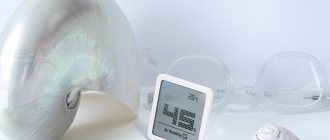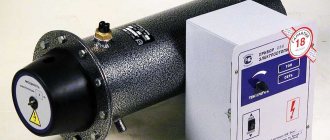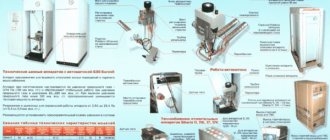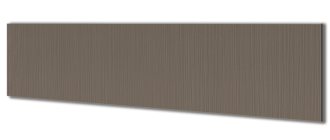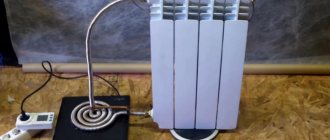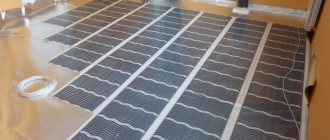The principle of heating materials by induced high-frequency currents has long been used in industry. The method can be used in everyday life to heat water, including for heating a house, since energy transfer occurs more efficiently and with fewer losses. Let's look at what an induction heater is, how it works, what pros and cons it has, and what are the features of making it yourself.
Induction type water heating unit Source by.kotel-electr.ru
Induction heating - what is it, application
Currently, the industry widely uses the method of non-contact heating of workpieces before performing various types of operations - melting, welding, soldering, forging, etc. Its efficiency is so high that it is quickly replacing traditional heating methods. Moreover, due to the peculiarities of energy transfer - without the use of a conductor - losses are minimal, and therefore the method has a high economic indicator.
Induction heating is an increase in the temperature of objects made of electrically conductive materials through the action of an alternating magnetic field in their structure. The technological essence of the procedure is as follows:
- The object that needs to be heated is placed inside an inductor - a conductor twisted in the form of a spiral.
- Next, alternating currents of high strength and different frequencies are sent to the inductor through a special generator.
- As a result, the conductor begins to emit an alternating magnetic field.
- An electrically conductive object is penetrated by this field, as a result of which induced currents arise in it.
- Under the influence of eddy currents, the temperature of the material increases.
The simplest induction heating device Source ytimg.com
This “inductor-object” circuit is essentially a transformer without a core. In it, the inductor is the primary winding, the object is the short-circuited secondary. The magnetic field flows are closed between them through the air. In powerful industrial installations, the inductor conductor itself can become very hot, so to ensure safety, a cooling system is connected to it.
The principle of induction heating is widely used in a wide variety of fields:
- Non-contact welding, melting and soldering of ultra-high purity.
- Heat treatment and bending of elements and assemblies in the automotive industry.
- Creation of experimental samples of alloys.
- Jewelry making.
- Hardening of products on the surface.
- Heat treatment of small-sized parts that are not accessible to plasma and arc.
- Heat treatment and hardening of elements of complex shapes.
- Disinfection of devices and instruments in medicine.
Instantaneous water heater is one of the most commonly used applications of induction heating in the home Source equipmaster.ru
On a note! The non-contact heating method has also found wide application in the manufacture of household heating devices, especially for water. However, in price, such models are significantly superior to traditional analogues operating on heating elements. Therefore, with sufficient experience, you can make them yourself.
Electricity source
As we remember, our induction heater circuit assumes the presence of a power source. It applies voltage to the coil, causing the core and coolant to heat up. What can act as an alternating current source? An ordinary electrical network will not suit us - the frequency of the current in it is too low. We are left with two power sources:
An inverter welding machine makes an excellent power source for an induction heater.
- induction kitchen oven;
- inverter welding machine.
If you have an induction oven that you don't mind taking apart, use it. The disadvantage of the stove will be its too low power. Therefore, we recommend using an inverter welding machine. Just connect the coil to the output of the device and plug it into the network - our homemade induction heater, which we assembled with our own hands, is ready to start and use.
Please note that now you should take care of the proper design of the heater. To make it safe, place the coil in some neat housing. For example, this could be a thick plastic pipe of large diameter
Place the coil in it, and then secure the entire structure in its original place. Connect the heating pipes to the homemade heater and try to start the system, checking its efficiency
For example, it could be a thick plastic pipe of large diameter. Place the coil in it, and then secure the entire structure in its original place. Connect the heating pipes to the homemade heater and try to start the system, checking its efficiency.
If you have knowledge in the field of designing electronic equipment, you can try to assemble an inverter converter for an induction heater with your own hands. A diagram of such a converter can be found on the Internet.
Please note that the power source must be powerful enough to ensure proper power to the heater and its output to maximum power. Otherwise, cold or barely warm batteries will await you.
Operating principle of the heater
The mechanism for generating heat in household electrical appliances of this type is based on the same law on which industrial installations operate. However, the scheme of their work has its own characteristics. First of all, they concern the device. Thus, a household induction instantaneous water heater consists of the following main elements:
- An inductor is a coil of copper wire. When a current passes through it, a magnetic field is formed, under the influence of which the electrically conductive material of the heater is heated.
- A generator is a converter of stable household current into a high-frequency flow required in terms of power.
Operating principle of an induction water heater Source vinteplo.ru
See also: Catalog of companies that specialize in engineering systems (heating, water supply, sewerage and others) and related work
- The heating element is a metal pipe through which a water flow is passed to produce heating. The heater simultaneously functions as a cooler for the inductor, thereby providing it with stable operating characteristics and durability.
The generator converts the current from normal to high-frequency and supplies it to the coil. The wire winding produces a magnetic field. The tube heater located inside it heats up and transfers heat to the water flow passing through it. Due to the absence of direct contact during the transition from one type of energy to another, losses are minimal. The efficiency of such electric heaters reaches 98%.
Reference! An induction boiler works according to a similar scheme discussed above, which is an economical, efficient and durable heater for the home. Only instead of a tube, a heat exchange circuit is placed in the inductor, passing through which a special coolant is heated and distributed over all radiators of the living area.
Design and principle of operation of an induction boiler for heating Source oboiman.ru
Review of manufacturers
Well-known Russian manufacturers:
- Miratron;
- Edison;
- Geyser.
Miratron allows the owner to change the power of the unit - 4.5–30 kW.
The heater and automation are in the box
The powerful Edison boiler is equipped with the necessary automation.
Heater Edison
The geyser with a power of 4.5 - 250 kW has a 2nd safety class and does not require grounding.
Geyser heater with automatic
When there is complete information about boilers, it is easier to choose. User review:
average rating 0
more than 0 ratings
Share link
Comments
Kirill Vasilievich 10.24.2021 13:26
And induction coils can be made of two parallel busbar conductors at once, but with a different arrangement - flat and rib. The result is a double-circuit system of coils, and currents must flow in it in different directions alternately in a pulsating mode, with a frequency of hundreds of kilohertz. An asymmetric electromagnetic field arises in which the density vibrates with the oscillation frequency.
Advantages and disadvantages
The advantages of a household water heater of this type are as follows:
- Long service life. The average warranty period for most manufacturers is 30 years. At the same time, the installation does not require serious maintenance and repair with the replacement of main elements throughout the entire period of operation. Preventative cleaning is carried out no more than once every 7-9 years.
- Economical energy consumption. To produce the same amount of heat, in comparison with varieties operating on traditional heating elements, 30-40% less energy is spent.
- No scale. The specific mechanism of operation of the device eliminates the formation of scale on the working elements of the installation. In addition, when the device is turned on, it vibrates slightly, which is also a good protective factor against the build-up of various types of deposits on its internal parts in contact with water.
- Minimal risk of leaks. Non-contact heating technology eliminates the factors of destruction - when metal elements quickly rust under the influence of heat and dampness.
An induction water heater is reliable, durable and economical Source rusolymp.ru
Water boiler with transformer
To get started, get or buy an inexpensive welding inverter (transformer) with current regulation of 18-25 amperes. Small pieces of wire rod or stainless steel are used as elements for heating water in a water heater. The wire is cut into pieces of length from 3.8 to 5.5 cm (if a wire rod with a diameter of 6-8 mm is used). Then the heater body is made from a thick-walled plastic pipe with a diameter of 45-50 mm. One end of this section of pipe is covered with a fine mesh and cut wire is poured from the free open end of the body.
induction heater design diagram.
Having filled the pipe to the top with scraps, they begin to manufacture the inductor coil. Take an enameled copper wire of at least 1.5-2 mm and wind it around the made body. The number of turns varies (depending on the amperage of the welding inductor) and is 85-95. The coil is placed in the center of the body (pipes with scraps). The heater is connected to the water supply system or heating network using adapters.
To make a vortex induction boiler-water heater based on the resulting heater, you need to weld a structure resembling a donut from two pipes. This is a water heating element. Take any tank of suitable diameter and insert the inlet (in the upper part of the tank) and outlet pipes for water into it. The previously made induction coil is inserted into this housing. Then attach the heater (donut) to the nozzles so that it passes inside the inductor strictly in the center. The output ends of the coil are insulated and connected to the transformer. To prevent heat from leaving the water heater, it is covered with a heat-insulating screen.
Water, passing through the pipes inside the coil, heats up and comes out of the outlet pipe hot.
Such an induction boiler-water heater can also be connected to a system made of plastic pipes. To ensure safety, the boiler is installed at a distance of 80-90 cm from the floor and ceiling and 30-40 cm from the wall. This water heater must be equipped with a valve installed on the pipe to bleed air from the system. Such a boiler can also be used as a heater for a small room by adding a heating radiator.
Features of self-production
In order to make an induction heater, you must have experience in electrical work and assembling homemade electrical appliances, as well as skills in processing metal and other materials and be able to install wiring. Therefore, in their absence, it is better to entrust such work to professionals. In this case, the general algorithm for manufacturing the device consists of the following sequential stages:
- Making a heater. As a rule, a section of thick-walled metal pipe with adapters at the ends is used, enclosed in a heat-resistant plastic tube of a larger diameter.
Electrical circuit diagram
Here is the original circuit of the induction heater generator, and below it is a slightly modified version, according to which the design of the mini HDTV installation was assembled. There is nothing in short supply here - you only have to buy field-effect transistors; you can use BUZ11, IRFP240, IRFP250 or IRFP460. The capacitors are special high-voltage, and the power will be from a 70 A/h car battery - it will hold current very well.
The project turned out to be surprisingly successful - everything worked, although it was assembled “on the knee” in an hour. I was especially pleased that it does not require a 220 V network - car batteries allow you to power it even in the field (by the way, can you make a camp microwave out of it?). You can experiment in the direction of reducing the supply voltage to 4-8 V as from lithium batteries (for miniaturization) while maintaining good heating efficiency. Of course, it won’t be possible to melt massive metal objects, but it will work for small jobs.
The current consumption from the power supply is 11 A, but after warming up it drops to about 7 A, because the metal resistance increases noticeably when heated. And do not forget to use thick wires here that can withstand more than 10 A of current, otherwise the wires will become hot during operation.
Video description
Video example of making an induction heater:
- Creation of an inductor. An insulated copper wire with a cross-section of about 1-1.5 mm2 is tightly wound around the tube. The number of turns must be at least 90.
- Selecting a suitable alternator. The simplest and most affordable way is to use an inverter from an appropriate welding unit.
- Connecting the heater with the inductor to the water supply or heating pipe.
- Connecting the inductor to the network. The contact wires from the coil are connected to the positive contacts of the inverter.
- Power supply. Rectifier diodes are installed at the terminals. Without them, the voltage of the supplied current will be supplied rectified, and the coil will function as an electromagnet rather than an inductor.
- Turning on and checking the operation of the device.
Note! A self-made heater, unlike factory-made analogues, is not equipped with a protection and control system. Therefore, before turning it on, you must make sure that the heating element is filled with water.
Inductor in the kitchen
Induction hob
Induction hobs have become commonplace in the kitchen, see fig. According to the principle of operation, this is the same induction stove, only the bottom of any metal cooking vessel acts as a short-circuited secondary winding, see fig. on the right, and not just from ferromagnetic material, as the ignorant often write. Aluminum cookware is simply falling out of use; doctors have proven that free aluminum is a carcinogen, and copper and tin have long been out of use due to toxicity.
Household induction cookers are a product of the age of high technology, although the idea arose simultaneously with induction melting furnaces. Firstly, to isolate the inductor from the cooking, a durable, resistant, hygienic and EMF-free dielectric was needed. Suitable glass-ceramic composites have come into production relatively recently, and the top plate of the slab accounts for a significant portion of its cost.
Kitchen induction hob diagram
Then, all cooking vessels are different, and their contents change their electrical parameters, and the cooking modes are also different. A specialist will not be able to do this by carefully tightening the knobs to the desired fashion; you need a high-performance microcontroller. Finally, according to sanitary requirements, the current in the inductor must be a pure sinusoid, and its magnitude and frequency must vary in a complex way according to the degree of readiness of the dish. That is, the generator must have digital generation of the output current, controlled by the same microcontroller.
There is no point in making a kitchen induction hob yourself: more money will be spent on electronic components alone at retail prices than on ready-made good tiles. And it’s still quite difficult to control these devices: anyone who has one knows how many buttons or sensors there are with the inscriptions: “Stew”, “Roast”, etc. The author of this article saw a tile that separately listed “Navy Borscht” and “Pretanier Soup.”
However, induction cookers have many advantages over others:
- Almost zero, unlike microwave ovens, PPE, even if you sit on this tile yourself.
- Possibility of programming for preparing the most complex dishes.
- Melting chocolate, rendering fish and poultry fat, preparing caramel without the slightest sign of burning.
- High efficiency as a result of fast heating and almost complete concentration of heat in the cooking vessel.
Heating up cooking utensils on an induction hob and gas burner
To the last point: take a look at fig. on the right, there are schedules for heating up cooking on an induction stove and a gas burner. Anyone who is familiar with integration will immediately understand that an inductor is 15-20% more economical, and there is no need to compare it with a cast-iron “pancake”. The cost of money on energy when preparing most dishes for an induction cooker is comparable to that of a gas cooker, and even less for stewing and cooking thick soups. The inductor is so far inferior to gas only during baking, when uniform heating is required on all sides.
Briefly about the main thing
Induction heating is based on the ability of an alternating magnetic field to increase the temperature of objects made of electrically conductive materials. Heating is carried out in a non-contact manner and is characterized by high performance and low energy losses. For this reason, the method is widely used in various fields - melting, welding, soldering of metals, heat treatment of components and elements in production, disinfection of instruments in medicine.
The same principle applies to the operation of a domestic water heater. The heating element through which the water passes is placed in an inductor coil. When a high-frequency current is applied, an alternating magnetic field is generated, heating the metal heater. Among the main advantages of such devices are:
- Durability.
- Economy.
- No scale.
- Leak-free operation.
- Natural convection.
Disadvantages are associated with the release of heat into the surrounding space, the need for a stable power supply, constant monitoring of performance characteristics, operating noise and harmful radiation. When manufacturing the device, you must follow the instructions and have sufficient experience.
Safety Tips
Installations of this type are widely used not only for space heating, but also for smelting operations. The main problem with home-made induction devices is the lack of components that provide temperature and pressure control and explosion protection. Therefore, when operating such units, care and caution must be exercised.
Before starting the induction boiler, it is necessary to fill the system with coolant
Before starting the boiler, check that the cavity is filled with coolant. A case made of polymers will begin to melt without regular cooling with liquid. This entails deformation changes and complete failure of the installation. Also dangerous can be the fall of hot metal from the melting body. In the event of such an incident, it will be necessary to replace a number of installation components.
The device is connected to electricity through a separate wire, which is led from the switchboard. The contacts must be covered with insulating material. If the design involves a welding machine, its inverter must be grounded. The wire used for this operation should be 4-6 mm in diameter. To prevent excessive heating of the installation in the absence of water, it is advisable to install an excess pressure valve in the inlet.

